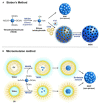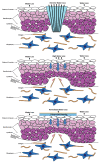Silicon-Based Scaffold for Wound Healing Skin Regeneration Applications: A Concise Review
- PMID: 36236170
- PMCID: PMC9571903
- DOI: 10.3390/polym14194219
Silicon-Based Scaffold for Wound Healing Skin Regeneration Applications: A Concise Review
Abstract
Silicon has made its breakthrough in various industries, including clinical and biomedical applications. Silicon-based biomaterials that were fabricated into various types of scaffolds may attract interest due to their highly favorable properties covering their excellent biocompatibility, high surface area, mechanical strength, and selectivity depending on their application including film, hydrogel, nanoparticles, and so on. Silicon-based materials have also shown exciting results involving cell culture, cell growth, as well as tissue engineering. In this article, a simple review compromising the evaluation of silicon's unique properties has been discussed and followed by the application of the silicone-based product in future perspectives in biomedical fields. The review goals are to widen and inspire broader interest in silicone-based materials in wound healing research.
Keywords: silicone; skin regeneration; tissue engineering; wound healing.
Conflict of interest statement
The authors declare no conflict of interest. The funders had no role in the design of the study; in the collection, analyses, or interpretation of data; in the writing of the manuscript, or in the decision to publish the results.
Figures






Similar articles
-
Silk biomaterials in wound healing and skin regeneration therapeutics: From bench to bedside.Acta Biomater. 2020 Feb;103:24-51. doi: 10.1016/j.actbio.2019.11.050. Epub 2019 Dec 2. Acta Biomater. 2020. PMID: 31805409 Review.
-
Chitosan/Hyaluronic acid/Alginate and an assorted polymers loaded with honey, plant, and marine compounds for progressive wound healing-Know-how.Int J Biol Macromol. 2021 Sep 1;186:656-685. doi: 10.1016/j.ijbiomac.2021.07.067. Epub 2021 Jul 14. Int J Biol Macromol. 2021. PMID: 34271047 Review.
-
Bioactive antibacterial silica-based nanocomposites hydrogel scaffolds with high angiogenesis for promoting diabetic wound healing and skin repair.Theranostics. 2020 Mar 31;10(11):4929-4943. doi: 10.7150/thno.41839. eCollection 2020. Theranostics. 2020. PMID: 32308759 Free PMC article.
-
Polymeric Hydrogel Scaffolds: Skin Tissue Engineering and Regeneration.Adv Pharm Bull. 2022 May;12(3):437-448. doi: 10.34172/apb.2022.069. Epub 2021 Sep 14. Adv Pharm Bull. 2022. PMID: 35935050 Free PMC article. Review.
-
Prospects of nonmulberry silk protein sericin-based nanofibrous matrices for wound healing - In vitro and in vivo investigations.Acta Biomater. 2018 Sep 15;78:137-150. doi: 10.1016/j.actbio.2018.07.047. Epub 2018 Jul 29. Acta Biomater. 2018. PMID: 30059800
Cited by
-
Self-Healing Silicone Materials: Looking Back and Moving Forward.Biomimetics (Basel). 2023 Jul 3;8(3):286. doi: 10.3390/biomimetics8030286. Biomimetics (Basel). 2023. PMID: 37504174 Free PMC article. Review.
-
Most Important Biomedical and Pharmaceutical Applications of Silicones.Materials (Basel). 2025 May 30;18(11):2561. doi: 10.3390/ma18112561. Materials (Basel). 2025. PMID: 40508558 Free PMC article. Review.
-
A critical overview of challenging roles of medicinal plants in improvement of wound healing technology.Daru. 2024 Jun;32(1):379-419. doi: 10.1007/s40199-023-00502-x. Epub 2024 Jan 15. Daru. 2024. PMID: 38225520 Free PMC article.
-
Drug-Loaded Bioscaffolds for Osteochondral Regeneration.Pharmaceutics. 2024 Aug 21;16(8):1095. doi: 10.3390/pharmaceutics16081095. Pharmaceutics. 2024. PMID: 39204440 Free PMC article. Review.
-
Characterization of Dual-Layer Hybrid Biomatrix for Future Use in Cutaneous Wound Healing.Materials (Basel). 2023 Jan 29;16(3):1162. doi: 10.3390/ma16031162. Materials (Basel). 2023. PMID: 36770168 Free PMC article.
References
Publication types
Grants and funding
LinkOut - more resources
Full Text Sources

